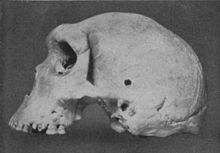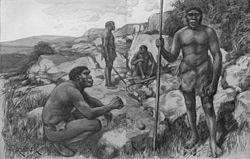This is an old revision of this page, as edited by 69.137.95.213 (talk) at 17:24, 6 January 2014 (→Discovery). The present address (URL) is a permanent link to this revision, which may differ significantly from the current revision.
Revision as of 17:24, 6 January 2014 by 69.137.95.213 (talk) (→Discovery)(diff) ← Previous revision | Latest revision (diff) | Newer revision → (diff)| It has been suggested that this article be merged into Homo heidelbergensis. (Discuss) Proposed since March 2013. |
| Homo rhodesiensis Temporal range: Pleistocene, 0.4–0.12 Ma PreꞒ Ꞓ O S D C P T J K Pg N ↓ | |
|---|---|

| |
| Skull found in 1921 | |
| Scientific classification | |
| Kingdom: | Animalia |
| Phylum: | Chordata |
| Class: | Mammalia |
| Order: | Primates |
| Family: | Hominidae |
| Tribe: | Hominini |
| Genus: | Homo |
| Species: | H. rhodesiensis |
| Binomial name | |
| †Homo rhodesiensis Woodward, 1921 | |
Homo rhodesiensis (Rhodesian man) is an extinct hominin species of the genus Homo, described from the fossil Kabwe skull. Other morphologically-comparable remains have been found from the same, or earlier, time period in southern Africa (Hopefield or Saldanha), East Africa (Bodo, Ndutu, Eyasi, Ileret) and North Africa (Salé, Rabat, Dar-es-Soltane, Djbel Irhoud, Sidi Aberrahaman, Tighenif). These remains were dated between 300,000 and 125,000 years old.
Homo rhodesiensis is now regarded by some scientists as another name for Homo heidelbergensis.
Discovery
Kabwe 1, also called the Broken Hill skull, was assigned by Arthur Smith Woodward in 1921 as the type specimen for Homo rhodesiensis; today most scientists now assign it to Homo heidelbergensis. The cranium was found in a lead and zinc mine in Broken Hill, Northern Rhodesia (now Kabwe, Zambia) in 1921 by Tom Zwiglaar, a Swiss miner. In addition to the cranium, an upper jaw from another individual, a sacrum, a tibia, and two femur fragments were also found. The skull was dubbed "Rhodesian Man" at the time of the find, but is now commonly referred to as the Broken Hill skull or the Kabwe cranium.
The association between the bones is unclear, but the tibia and femur fossils are usually associated with the skull. Rhodesian Man is dated to be between 125,000 and 300,000 years old. Cranial capacity of the Broken Hill skull has been estimated at 1,230 cm³. Bada, & al., (1974) published the direct date of 110 ka for this specimen measured by aspartic acid racemisation. The destruction of the paleoanthropological site has made layered dating impossible.
The skull is from an extremely robust individual, and has the comparatively largest brow-ridges of any known hominid remains. It was described as having a broad face similar to Homo neanderthalensis (i.e. large nose and thick protruding brow ridges), and has been interpreted as an "African Neanderthal". However, when regarding the skulls extreme robustness, recent research has pointed to several features intermediate between modern Homo sapiens and Neanderthal.
Another specimen, "the hominid from Lake Ndutu" may approach 400,000 years old; Clarke in 1976 classified it as Homo erectus. Indirect cranial capacity estimate is 1100 ml. Its supratoral sulcus morphology and the presence of protuberance as suggested by Philip Rightmire give the Nudutu occiput an appearance which is also unlike that of Homo erectus, but Stinger 1986 pointed that thickened iliac pillar is typical for Homo erectus.
Classification

In Africa, there is a distinct difference in the Acheulian tools made before and after 600,000 years ago with the older group being thicker and less symmetric and the younger being more extensively trimmed. This may be connected with the appearance (some 300,000 years later) of Homo rhodesiensis in the archaeological record at this time who may have contributed this more sophisticated approach.
Rupert Murrill has studied the relations between Archanthropus skull of Petralona (Chalcidice, Greece) and Rhodesian Man. Most current experts believe Rhodesian Man to be within the group of Homo heidelbergensis though other designations such as Homo sapiens arcaicus and Homo sapiens rhodesiensis have also been proposed.
According to Tim White, it is probable that Rhodesian Man was the ancestor of Homo sapiens idaltu (Herto Man), which itself was the ancestor of Homo sapiens sapiens. The skull has cavities in ten of the upper teeth and is considered one of the oldest known occurrences of cavities. Pitting indicates significant infection before death and implies that the cause of death may have been due to dental disease infection or possibly chronic ear infection.
See also
- List of fossil sites (with link directory)
- List of hominina (hominid) fossils (with images)
References
- ^ "Kabwe 1". The Smithsonian Institution's Human Origin Program. Retrieved 2 November 2010.
- Stringer, Chris (2011). The Origin of our Species. Penguin. p. 202. ISBN 978-0-141-03720-2.
- Johansson, Donald; Edgar, Blake (2006). From Lucy to Language. Simon & Schuster. p. 222. ISBN 978-0-7432-8064-8.
- Begun, David R., ed. (2012). "The African Origin of Homo Sapiens". A Companion to Paleoanthropology. John Wiley & Sons. ISBN 9781118332375.
- Rightmire, G. Philip. The Evolution of Homo Erectus: Comparative Anatomical Studies of an Extinct Human Species Cambridge University Press, 1993. ISBN 0-521-44998-7, ISBN 978-0-521-44998-4.
- Bada, Jeffrey L., Roy A. Schroeder, Reiner Protsch, and Rainer Berger. Concordance of Collagen-Based Radiocarbon and Aspartic-Acid Racemization Ages PNAS abstract URL.
- Amino Acid Racemization Dating of Fossil Bones
- Rightmire, G. Philip (2005). "The Lake Ndutu cranium and early Homo Sapiens in Africa". American Journal of Physical Anthropology. 61 (2): 245–254. doi:10.1002/ajpa.1330610214. PMID 6410925.
- The Evolution of Homo Erectus: Comparative Anatomical Studies of an Extinct Human Species By G. Philip Rightmire Published by Cambridge University Press, 1993 ISBN 0-521-44998-7, ISBN 978-0-521-44998-4
- White, Tim D.; Asfaw, B.; DeGusta, D.; Gilbert, H.; Richards, G. D.; Suwa, G.; Howell, F. C. (2003). "Pleistocene Homo sapiens from Middle Awash, Ethiopia". Nature. 423 (6491): 742–747. doi:10.1038/nature01669. PMID 12802332Template:Inconsistent citations
{{cite journal}}: CS1 maint: postscript (link)
Literature
- Woodward, Arthur Smith (1921). "A New Cave Man from Rhodesia, South Africa". Nature. 108 (2716): 371–372. doi:10.1038/108371a0.
- Singer Robert R. and J. Wymer (1968). "Archaeological Investigation at the Saldanha Skull Site in South Africa". The South African Archaeological Bulletin. 23 (3). The South African Archaeological Bulletin, Vol. 23, No. 91: 63–73. doi:10.2307/3888485. JSTOR 3888485.
- Murrill, Rupert I. (1975). "A comparison of the Rhodesian and Petralona upper jaws in relation to other Pleistocene hominids". Zeitschrift für Morphologie und Anthropologie. 66: 176–187..
- Murrill, Rupert Ivan (1981). Ed. Charles C. Thomas (ed.). Petralona Man. A Descriptive and Comparative Study, with New Information on Rhodesian Man. Springfield, Illinois: Thomas. ISBN 0-398-04550-X.
- Rightmire, G. Philip (2005). "The Lake Ndutu cranium and early Homo Sapiens in Africa". American Journal of Physical Anthropology. 61 (2): 245–254. doi:10.1002/ajpa.1330610214. PMID 6410925..
- Asfaw, Berhane (2005). "A new hominid parietal from Bodo, middle Awash Valley, Ethiopia". American Journal of Physical Anthropology. 61 (3): 367–371. doi:10.1002/ajpa.1330610311. PMID 6412559..
| Human evolution | |||||||||||||||||||||||||||
|---|---|---|---|---|---|---|---|---|---|---|---|---|---|---|---|---|---|---|---|---|---|---|---|---|---|---|---|
| Taxonomy (Hominins) |
| ||||||||||||||||||||||||||
| Ancestors |
| ||||||||||||||||||||||||||
| Models |
| ||||||||||||||||||||||||||
| Timelines | |||||||||||||||||||||||||||
| Others | |||||||||||||||||||||||||||
| |||||||||||||||||||||||||||